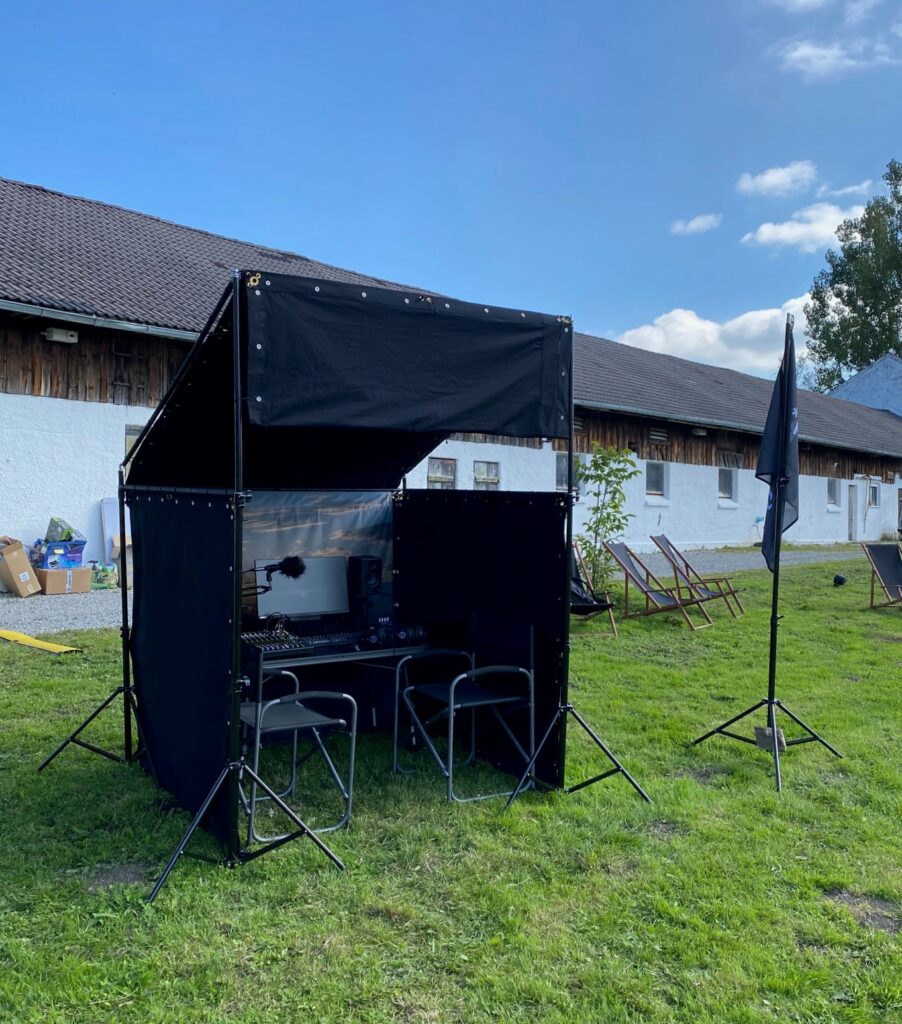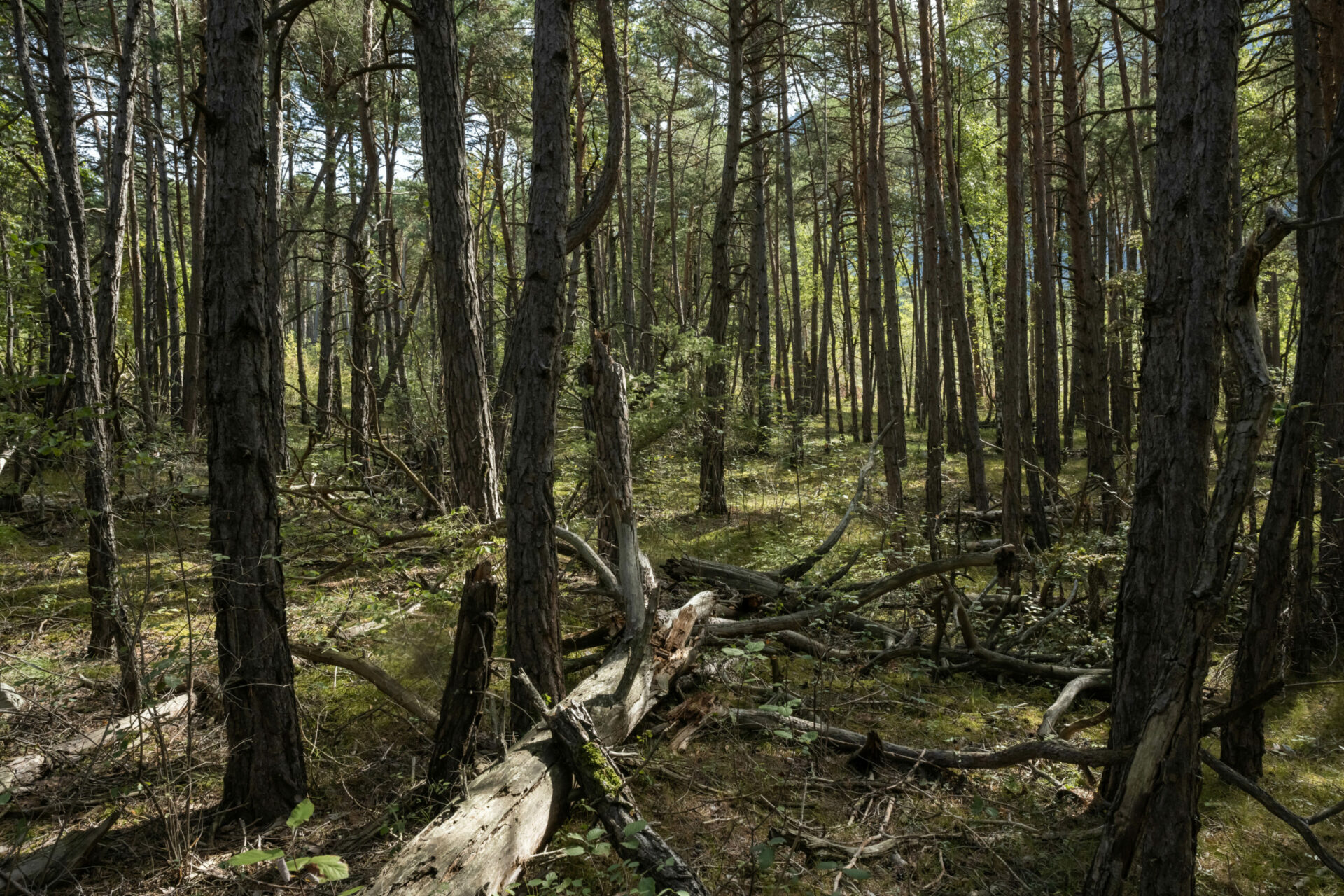Marcus Maeder: Posterity, installation/webradio, inauguration at LiteraturFestivalNantesbuch, Stiftung Kunst & Natur, Nantesbuch, Germany, 24. – 26. 9. 2021

Posterity* is an artistic-scientific listening post that observes the soundscape of Nantesbuch near Bad Heilbrunn in southern Bavaria. Five automatic recorders have been placed in the landscape, recording the local soundscape at hourly intervals. If you turn on the radio on this page, you will hear a sound stream of the environmental sounds from Nantesbuch. The hourly, five-minute recordings from the automatic recorders are crossfaded without interruption – and the radio jumps from one location to the next every five minutes. This creates a spatiotemporal compression of your acoustic landscape experience – like traveling through time and flying from one place to the next. Your acoustic visit to the landscape of Nantesbuch is retrospective: what can be heard are the last three months (and further back), since the recordings have to be read out manually each time and uploaded to the server.
The foothills of the Alps in southern Bavaria are shaped by the glaciers that flowed here from the inner Alpine region into the lowlands tens of thousands of years ago. They left behind a humid landscape with many moors and lakes. Although the landscape of Nantesbuch is sparsely populated, it was nevertheless intensively used by man. The nutrient-poor, humid soils did not allow much: agricultural activities were limited to grass farming, cattle and forestry; peat was cut. Many moors and wet meadows were drained, and fast-growing spruce forests were planted along the edges of the moors. This landscape is now beginning to change. On the one hand, areas on the property of the Art & Nature Foundation in Nantesbuch have been re-naturalized in recent years: Meadows are no longer cultivated, are re-wetting, and the Haselbach stream has been given a natural, meandering course; livestock farming is practiced in small and sustainable units. On the other hand, however, effects of climate change are beginning to manifest, even in the previously damp and cool foothills of the Alps: Moors dry up during heat periods, the microclimate gets too hot and dry for spruce trees – they are attacked by bark beetles and die. Extreme weather events such as heavy rain on the one hand or long drought periods on the other reshape the landscape. As temperatures rise, the composition of local fauna and flora changes.
The acoustic observation of a landscape is always a holistic one: An audio recording contains everything that can be heard. A soundscape is structured into geophonies (sounds of inanimate nature such as wind or rain), biophonies (sounds of animate nature such as animal sounds) and anthropophonies (sounds of humans and technology). These sound sources overlap and influence each other. The noise of a road can have an influence on the song of birds; the sound of a river shapes the basic tonal character of a landscape. Acoustic ecology is devoted to the scientific and aesthetic study of soundscapes. And as the name suggests, it examines the ecological implications and connections behind the sounds we hear in a landscape.
The focus of this long-term artistic-scientific project is on what is to come: As an acoustic observatory, *Posterity monitors the dynamics of the soundscape in Nantesbuch over several years. Are there different, more or less numerous animals heard in selected areas over longer periods of time? Is biodiversity increasing or decreasing? What influence does human noise have on the soundscape? As vegetation changes, do its sounds change? How often does it rain? How does a meadow, a forest, a moor, a stream, a permaculture garden sound in three to five years compared to today? What is the relationship between climatic/meteorological conditions and the sound sources in the Soundscape of Nantesbuch?
Do positive changes outweigh the negative ones? This is symbolized by the picture on this homepage: Are we seeing a sunrise or sunset? Twilight marks a period of transition: from day to night, from night to day. From a cultural perspective, we are also in a time of transition. What is required is a new relationship with nature, which must be reflected in a radically different way of dealing with the natural environment. Only in this way the sunset of the impending climate catastrophe and the loss of global biodiversity may become the dawn of a newly perceived and lived participation in planetary and local ecosystems.
The sonic confrontation with the environment can be helpful here. Sound creates intimacy and immersion – things come close to us through our hearing, we become immersed in the sounds of the landscape when for once the visual experience is not the primary focus. On the one hand, because recorders amplify environmental sounds, we hear more than we would with our ears in the landscape. On the other hand, we do not disturb wild animals by our presence and can listen to them unobtrusively with technical help. This is the most important keyword: Listening, learning to listen to nature. Even experienced ecoacousticians have to learn this over and over again. What is the nature of the recorded material, which sound sources can be identified, what do they mean, how do they influence each other, how do they affect us? *Posterity is a public research tool where the participation of all interested listeners is requested: Do you notice anything special in the sound flow? Do you discover a connection between certain sounds, differences between places? The blog on this homepage is intended to provide space for this exchange – in addition to the artistic-scientific journal that is kept in it, a public dialogue about the soundscape Nantesbuch is to be created. Write your observations and questions in the comments!
To be able to listen and explore the soundscape Nantesbuch specifically, use the sound map on this page. In the menu there or directly in the map you can select the locations you want to hear. In the same menu you can also set the date and time.
At the center of the recorder network in Nantesbuch, near the Karpfsee estate, there is a weather station that measures the weather conditions in minute intervals. The measured data comes to the *Posterity server, which sends it to your browser, where the most important weather data is sonified. If you select music on/off in the menu on the right, you will hear a generative music flow along with the environmental sounds. The music is controlled by the weather data you see in the menu – this is called data sonification: series of measurements, of numbers are used to control parameters like volume, pitch or timbre in the automatic generation of sounds or music. The sonification in *Posterity is especially elaborated and adapted to the expected weather conditions in this region: Depending on temperature, humidity, air pressure or wind strength, different sounds, chords and sound patterns are played. You may thus hear the current weather conditions and changes in the music and, with some practice, also discover connections with environmental sounds, with diurnal cycles and seasonal progressions. You can also turn off the music at any time to focus on the environmental sounds.
*Posterity is also present from time to time in the non-digital public sphere. As a sound installation and mobile, analog FM station, which you can also receive in your car or in completely unexpected places where it has a radio – with a special program or livestreams.
